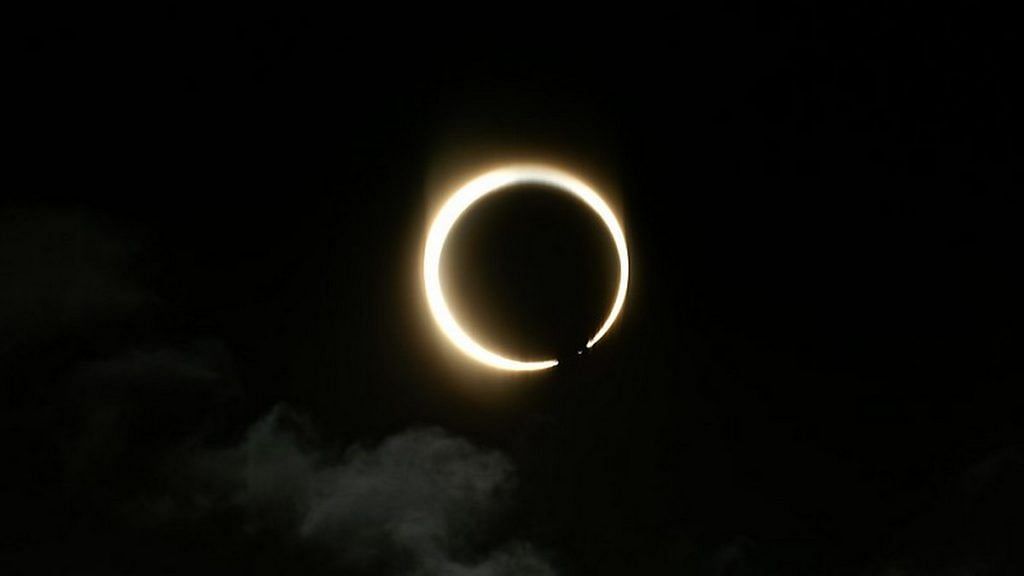Bengaluru: A day after Christmas, on 26 December, the moon will gently glide in between the Earth and Sun, blocking the view of Sun completely and leaving only its outer edges to form a bright ring around the moon.
This is called an annular solar eclipse and will be visible in several countries in Asia, including India.
The annular ring will, however, be seen only in parts of Karnataka, Kerala and Tamil Nadu. Kannur in Kerala will be the first city in India where the ring will be visible. The rest of the country will see it as a regular partial eclipse.
The eclipse will begin in Saudi Arabia and end at Guam island, an unincorporated territory of the United States in the North Pacific Ocean.
The annular eclipse will be visible in India at 9.24 am IST Thursday, even though it will be visible as a partial eclipse from 9.12 am.
Other cities where the annular eclipse can be seen are — Mangaluru (Karnataka), Kasaragod, Thalassery, Wayanad, Kozhikode, Palakkad (Kerala), Ooty, Coimbatore, Erode, Karur, Dindigul, Sivaganga, Trichy and Pudukkottai (Tamil Nadu).
The eclipse will exit India at 9.34 am IST, although the partial eclipse will continue to be visible for a few minutes afterwards.
The entire eclipse event will last a total of 3 hours and 13 minutes, although not all of it will be visible from India.
This will be the last eclipse of 2019 and the next solar eclipse will be a total solar eclipse, to be visible again from India, on 14 December 2020.
The annular eclipse occurs when the Moon is farther from the Earth in its orbit and doesn’t fully block out the Sun. Had the Moon been closer to Earth, it would have been a total eclipse, with the Sun completely blocked out.
How to observe the eclipse?
It is very dangerous to observe the Sun directly or through telescopes during a solar eclipse. It could even lead to blindness. Using an x-ray film is also not safe as they don’t fully filter out the infrared and ultraviolet radiation reaching the eyes.
It is also not advisable to use a lens to observe an eclipse. Avoid pointing cameras directly at an eclipse too, unless equipped with lens-protection filters for eclipses.
Observing the solar eclipse requires special glasses with filters. These are sold as ‘solar eclipse goggles’ and can be purchased in most cities.
Big telescope manufacturers also sell aluminium-coated mylar filter sheets that can fit over telescopes. Glasses used by welders are also safe for the eyes.
Perhaps the safest method to observe the eclipse is through pinhole projection: Create a small hole of about 3 mm radius in a cardboard paper or a thick sheet such as watercolour paper. Face away from the Sun and hold it up, so that the Sun’s rays can fall through the hole on to a wall or another sheet of paper. This effectively functions as a pinhole camera and ‘live streams’ the Sun on to your wall.
Remember to never look at the Sun through the hole in the paper.
Many local astronomy groups, colleges and planetariums have organised viewing events. Slooh.com has announced its regular live streaming event.
Myths surrounding eclipses
Every time an eclipse occurs, myths start floating around on social media and even on news websites about how dangerous it is to step out of home during eclipses or eat food.
These are misconceptions and superstitions, not rooted in science. It is perfectly alright to travel, start new projects, wear jewellery, cook and consume food during eclipses.
The only dangerous thing to do is to stare directly at the Sun without appropriate filters.
Also read: Lunar and solar eclipses make animals do strange things
